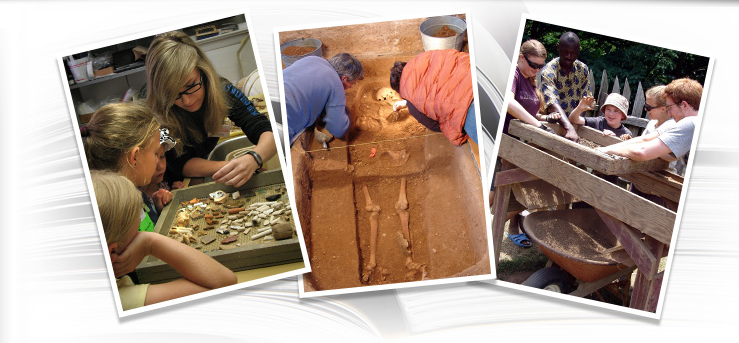2013 Week 8
As the weather turned hot this week, we stopped losing work time to rain and started losing it to the heat. Despite a short week, the students accomplished a lot of work and made some significant and exciting discoveries. We continued to follow some of the 17th-century fences.
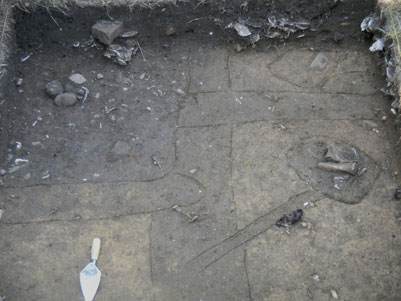
Unit with a complex of features including the early fence.
The photo shows the continuation of an early fence, first mentioned in week 5, and reveals the complexity in some of these situations. In the upper left is a 19th- or 20th-century feature filled with oyster shell, coal and brick. The unit pictured is located at the end of the row of service buildings related to the Brome House and the area shows frequent planting holes, fence posts and some trash disposal. The two small features to the right probably date to this period as well.
Of greatest interest for us are the linear features, two of which run left-right and one which runs from the top to the bottom. The latter feature is the continuation of the early fence. While we can not yet date this precisely, it certainly was built before the 1670s. It runs from the front of the foundation southward. The significance of this fence is that it divides the front yard between the public entrance to the house and the private area around the kitchen. The two left-right features represent later fences as they cut through the early fence. These indicate a different arrangement of space in the front yard.
We continued to find a wealth of colonial artifacts in the various units.
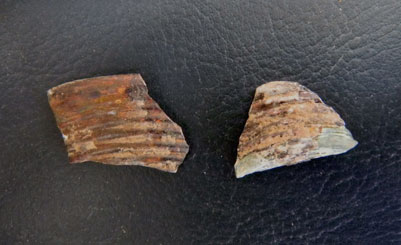
Fragile but elegant table glass fragments.
These included the two fragile pieces of table glass in the photo. They are parts of a tumbler with ridged decoration near the rim and similar examples have been found at other sites in St. Mary’s City. The amount of 17th-century table glass at the Calvert House site is really impressive.
The most significant work this week was done on the two major features we need to finish before the end of the season.
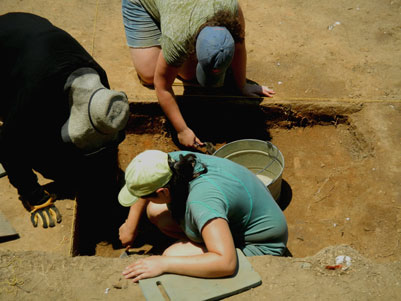
Beginning work on the early chimney base.
The first of these was a large rectangular feature which probably represents the original chimney on the north side of the house. Work in this feature was difficult as the soil was very hard but the students managed to find the bottom in part of it by the end of the week. The fill contains a large amount of ferrous sandstone, poorly fired brick and daub. None of the pieces is very big but they all suggest a chimney. Hopefully, by the end of next week, we will have good evidence of the function of this feature.
The most significant and exciting discovery of the week was in the excavation of the dark circular feature.
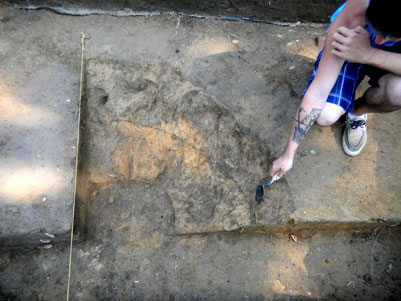
Circular feature which may be a cistern.
Having completed the excavation of the fences that cut across this feature, we removed a quarter of the dark soil and were surprised to see the circular features below. We had expected this to be a cellar but began to doubt that interpretation as the fences were excavated. Three types of soil are shown in the photo. The soil at the upper edges is our normal subsoil, seen all over the site. The middle soil is a hard-packed, red clay. Finally, at the bottom, is a mottled dark soil with oyster shells. What this shows is that at some point, they dug a circular hole, put something circular in it and then packed red clay around it. This appears to be what is termed a barrel well. However, unlike what we normally think of as a well, water did not seep into this feature. The clay was placed around it to make sure that water did not seep out of the feature. In this regard, it could be termed a cistern.
Like the fences above it, this feature dates to the early period of the site. The plow zone above the feature has large numbers of artifacts but the feature has no 17th-century artifacts yet. Had the feature been dug and filled in the later part of the 17th century, surface artifacts would have been included in the fill. The lack of such artifacts suggests that the feature was filled-in before many artifacts had time to accumulate on the yard surface. The artifacts that have been found are entirely Prehistoric.
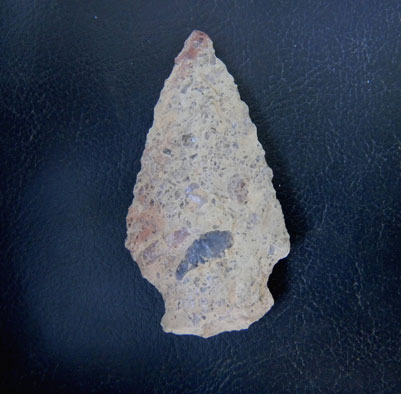
Projectile point made of silicified stone.
One of these is a projectile point made of silicified stone, a type of rock where silica is introduced into another substance, turning it into a rock. Petrified wood is an example of silicified stone. The type of point is described archaeologically as a Brewerton Side Notched and dates to the Late Archaic period (c. 4300-3500 BC).
In addition to the projectile point, several large pieces of Native American pottery have been found in the feature.
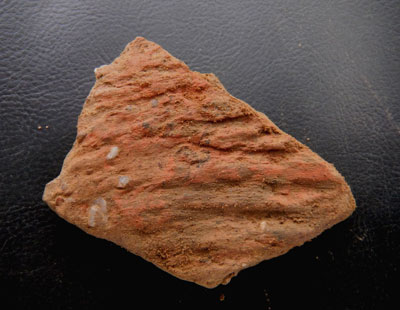
Cord-marked, gravel tempered Native American pottery.
The sherd in the picture is tempered with gravel and has deep cord-markings on the exterior. Pottery is associated with the Woodland Period (c. 1250 BC – 1600 AD). Further analysis will narrow the dating for this piece.
If the feature is a cistern, when and why was it created? There was a very good and reliable spring at the bottom of the nearby ravine which provided fresh water for the house. In fact, it is likely that the presence of the spring is why the house was located here. There was only one time in the history of the site when having a reserve supply of water might have been important. In 1645, there was a rebellion against Lord Baltimore as part of the English Civil War and the Calvert House was the center of that rebellion. A fort was built around the building by the rebels. It may be that the cistern was created so that the fort would have water in case they were surrounded and cut off from the spring. We will continue to work on this feature over the next two weeks.
Next week, we hold our major public event, Tidewater Archaeology Days, on Friday and Saturday, where we invite the public to come and help us find artifacts. In preparation for this event, we laid out new units and removed the topsoil. One of these units was located in the middle of the Brome House driveway and the students had to dig through the gravel to get to plow zone. As we were cleaning up this unit, a piece of a tobacco pipe bowl popped out.
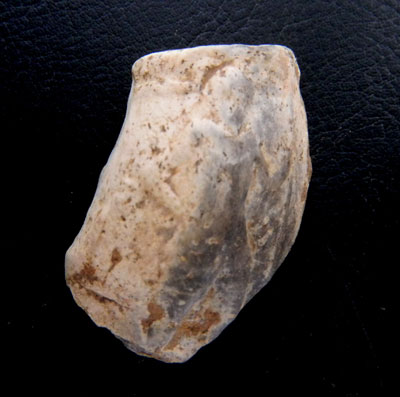
Tobacco pipe bowl with molded decoration.
This is a molded pipe with a pattern known as “Pikeman and Minerva” and dates to the late 17th-century. The finding of this beautiful artifact suggests that there will be interesting artifacts found this weekend.


